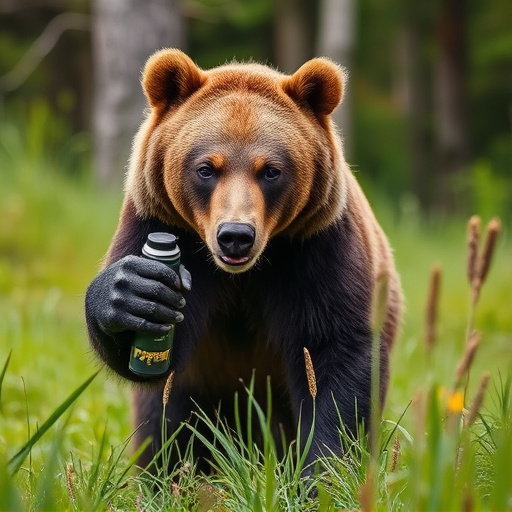Bear spray, a critical tool for human-bear interaction in the wild, has an average effective range of 30 feet (9 meters), influenced by factors like wind and terrain. Its use is regulated in many national parks and wildlife reserves due to environmental and legal considerations, with alternatives like noise makers or physical barriers recommended where it's banned. Proper usage involves understanding local regulations, training, targeting techniques, maintaining a safe distance, and appearing larger if spotted by a bear. Avoid areas where bear spray is prohibited for the safety of both humans and wildlife.
In bear country, understanding the effectiveness and range of bear spray is crucial for safety. This guide explores how far bear spray truly deters these powerful animals, shedding light on the definition of ‘effective deterrent’. We navigate legal considerations regarding bear spray use, highlighting areas where it’s prohibited. Additionally, we delve into factors influencing spray range and efficacy, offering best practices to maximize its effectiveness in allowed regions.
- Understanding Bear Spray Range: What Does 'Effective Deterrent' Mean?
- Legal Considerations: Where Is Bear Spray Use Prohibited?
- Factors Influencing Bear Spray Range and Efficacy
- Best Practices: Maximizing the Effectiveness of Bear Spray in Allowed Areas
Understanding Bear Spray Range: What Does 'Effective Deterrent' Mean?
Bear spray, also known as bear repellent, is designed to deter bears from approaching or attacking humans in wild environments. When discussing its effectiveness, understanding the range at which it operates is crucial. The term ‘effective deterrent’ implies that bear spray should prevent a bear encounter from escalating into a potentially dangerous situation within a specific distance.
The range of bear spray varies based on factors like the user’s breathing rate, wind conditions, and the spray’s concentration. Typically, bear spray can be effective up to 30 feet (approximately 9 meters), though some high-quality sprays might have an extended reach of up to 40 feet (12 meters). It is important to note that ‘prohibited’ areas for bear spray use are often determined by local regulations, considering both the potential risk to bears and human safety. Where bear spray is prohibited, alternative measures like noise makers or physical barriers might be recommended as primary deterrents.
Legal Considerations: Where Is Bear Spray Use Prohibited?
In some regions, the use of bear spray is heavily regulated due to legal and environmental concerns. National parks and wildlife reserves often prohibit the carrying of bear spray to protect both human visitors and local ecosystems. These areas may have specific rules regarding personal defense tools, prioritizing non-lethal methods of deterrence that minimize harm to wildlife.
It’s essential for individuals planning outdoor activities in known bear country to familiarize themselves with local regulations. Using bear spray where it’s prohibited can result in fines or other legal repercussions and may also disturb the natural behavior of bears, potentially endangering both humans and the animals.
Factors Influencing Bear Spray Range and Efficacy
The effectiveness and range of bear spray are influenced by several factors, including atmospheric conditions, terrain, and the user’s skill in deploying the spray. Wind direction and speed can significantly impact the spray’s reach; a tailwind can extend the range, while a headwind may reduce it. Humidity levels and temperature also play a role; moisture in the air can cause the spray to dissipate faster, while colder temperatures can make it more potent but also harder to deploy.
Additionally, the terrain’s roughness or smoothness affects how far the spray travels. In open areas with little obstructions, bear spray has been known to reach up to 30 feet (9 meters), but in dense forests or rugged terrain, the range typically diminishes. It’s important to note that where bear spray is prohibited, such as certain national parks or wilderness areas, this is often due to concerns about its impact on local ecosystems and wildlife, not because it’s ineffective; proper usage can still deter bears within its effective range.
Best Practices: Maximizing the Effectiveness of Bear Spray in Allowed Areas
When using bear spray in allowed areas, it’s crucial to follow best practices for maximizing its effectiveness. Firstly, always check local regulations and understand where bear spray is prohibited, as certain parks or wilderness areas may have strict rules. Secondly, ensure you have the proper training and licensing to carry and use bear spray. Practice targeting techniques beforehand; aim for the face and eyes, which are sensitive areas. Keep in mind that distance is critical; bear spray is most effective within a recommended range of 20-30 feet (6-9 meters).
Additionally, maintain awareness of your surroundings. Keep a safe distance from bears at all times and avoid provocations. If a bear spots you before you can deploy the spray, make yourself appear larger by raising your arms or jacket, speak firmly, and back away slowly. Never turn your back on a bear. Regularly inspect and maintain your spray device to guarantee it’s in working order. Remember, bear spray is a tool for protection when encountering bears in their natural habitat, but responsible behavior and awareness are equally vital.
Bear spray is an effective deterrent, but understanding its range and optimal use is key. By knowing legal restrictions on bear spray use and the factors influencing its effectiveness, outdoor enthusiasts can make informed decisions to ensure safety in bear country. Remember, while bear spray can be a powerful tool, it’s not a guarantee against encounters, and responsible usage in allowed areas is crucial to maintaining effective protection. Always check local regulations regarding where bear spray is permitted, and follow best practices for maximizing its efficacy during outdoor activities in bear-habitated regions.
